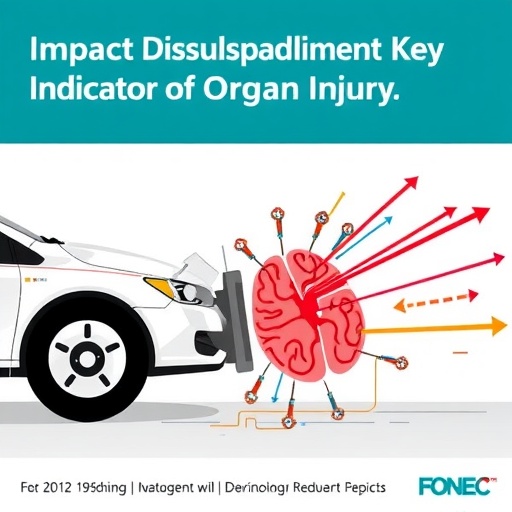
In a groundbreaking study published in the prestigious Annals of Biomedical Engineering, researchers led by Seifert, Koser, and Shah have unveiled new insights into the mechanics of thoraco-abdominal organ injuries resulting from impact. This research aims to refine our understanding of how such injuries can be predicted and ultimately mitigated, which is crucial for improving medical outcomes in traumatic injuries sustained during accidents and other high-impact scenarios. The meticulous comparison between isolated organ tests and comprehensive whole body tests illustrates the intricacies involved in body responses to trauma, enhancing the knowledge base for future engineering designs and safety protocols.
The key focus of this study is the application of impactor displacement as a predictive tool for assessing thoraco-abdominal organ injuries. By employing advanced biomechanical testing methodologies, the researchers meticulously analyzed how the displacement of impactors correlates with injury severity in various organ systems. This correlation is vital for the development of more accurate predictive models that can assist in the design of safer vehicles and protective gear. The researchers’ approach combines empirical data and theoretical modeling, which elevates the predictive accuracy regarding organ responses to direct and indirect trauma.
The methodology employed in this study is rigorous and multifaceted. The researchers utilized a combination of cadaveric studies and advanced imaging technology to analyze how organs react under different impact conditions. This dual approach allowed for a more nuanced understanding of the biomechanics involved in thoraco-abdominal injuries. Importantly, while isolated organ tests provide valuable insights, the whole body tests present a more realistic scenario, revealing how interconnected systems respond to trauma—a critical factor often overlooked in past studies.
Results from their experiments indicated significant variations in injury patterns when comparing isolated organ testing to whole body testing. In isolated scenarios, injuries were observed to occur at lower displacements than in conditions that accounted for the entire body. This finding is pivotal as it underscores the complex interplay between different organs and systems, suggesting that protective measures must consider the body as an interconnected unit rather than evaluating organs in isolation. Such revelations can directly influence how safety standards are conceptualized and implemented in medical engineering and vehicle safety designs.
The implications of this study extend beyond academic curiosity. By establishing a clearer predictive model based on impactor displacement, the research offers practical applications that could revolutionize current safety regulations. For healthcare professionals, this means more precise diagnostics and treatment plans based on enhanced predictive capabilities concerning trauma outcomes. Moreover, for engineers and safety designers, these findings bear significance in rethinking the conceptualization of protective designs and materials—potentially leading to innovations that could save lives in real-world accidents.
Further, the research endeavors to bridge the gap in knowledge regarding the mechanical thresholds that initiate organ trauma. Understanding these thresholds allows for targeted protective measures that could be implemented in various contexts—from automotive safety improvements to sports equipment advancements. With increasing recognition of how biomechanical forces affect health outcomes, this study also paves the way for future research into tailored injury prevention strategies that consider individual biomechanical profiles.
As the exploration of thoraco-abdominal organ injuries continues, the study acts as a catalyst for additional inquiries into the dynamics of injury prediction and prevention. With the rapid advancement in computational modeling and simulation technologies, future studies could focus on simulating a virtual predictive framework that incorporates real-time data analytics during accidents. This could ultimately transform emergency response strategies, enhancing the efficiency of interventions in critical medical situations.
The significance of this research cannot be overstated. Not only does it elevate the academic discourse surrounding biomechanics and organ injury, but it also emphasizes the pressing need for interdisciplinary collaboration between medical professionals, engineers, and policymakers. For instance, the integration of medical insights into engineering practices could lead to breakthroughs in creating adaptive safety systems that respond dynamically to different impact scenarios.
In conclusion, Seifert, Koser, and Shah’s research presents a pivotal step forward in understanding thoraco-abdominal injuries and refining traumatic injury prediction methods. As vehicular safety standards evolve and our comprehension of organ dynamics deepens, the study sets a precedent for future interdisciplinary research and innovations aimed at reducing the incidence and severity of bodily injuries resulting from high-impact events.
Innovative measures that stem from this research could further provoke legislative action, inspiring policymakers to impose stricter safety regulations in transportation and beyond. The lasting impact of these findings may well lead to safer environments and improved health outcomes for individuals exposed to high-risk situations. Ongoing dialogue within both the scientific community and industry stakeholders will be crucial in translating these findings into practical applications that ensure the welfare of individuals worldwide.
In summary, the collaborative efforts of this research team illuminate critical areas of biomechanical study and stress the importance of predictive modeling in understanding and preventing organ injuries caused by impact. It is a vital reminder of the symbiotic relationship between research, engineering innovation, and healthcare – culminating in advancements that prioritize human safety above all.
Subject of Research: Impact Predictor for Thoraco-Abdominal Organ Injury
Article Title: Impactor Displacement as a Predictor of Thoraco-Abdominal Organ Injury: Comparison of Isolated Organ to Whole Body Tests.
Article References: Seifert, J., Koser, J., Shah, A. et al. Impactor Displacement as a Predictor of Thoraco-Abdominal Organ Injury: Comparison of Isolated Organ to Whole Body Tests. Ann Biomed Eng (2025). https://doi.org/10.1007/s10439-025-03797-w
Image Credits: AI Generated
DOI:
Keywords: Impact prediction, thoraco-abdominal injury, biomechanics, trauma, engineering safety, organ response, predictive modeling, medical engineering.
Tags: advanced testing methodologies in biomedical engineeringbiomechanics of organ injuriescorrelation between impact force and organ damageempirical data in injury predictionenhancing medical outcomes in accident traumaimpact displacement in organ injury assessmentmitigation strategies for traumatic injuriespredictive modeling for injury severityprotective gear engineering for trauma preventionthoraco-abdominal trauma researchvehicle safety design improvementswhole body vs isolated organ testing




